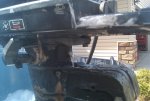steamking123
Seaman Apprentice
- Joined
- Aug 8, 2009
- Messages
- 42
I have a game fisher 7.5 1985 that I think is over heating. The obvious answer is the impeller is not pumping water. I am pretty sure the impeller is functioning. There is water mist coming out of the exhaust, and water pumps up to the plug at the top of the motor while running.
(see pic)
After running the motor for a few minutes I placed a surface thermometer on the motor (cylinder head) and got several readings ranging from 180 to 200 degrees f.
I have no idea how hot these little motors are suppose to get, but that seems too hot. From my research on this forum, I am pretty sure the cylinder head is air cooled, and the lower unit is what is water cooled.
anyone know what a normal temp reading for a cylinder head is on a small engine?
can the impeller be functioning at half measures?
(see pic)
After running the motor for a few minutes I placed a surface thermometer on the motor (cylinder head) and got several readings ranging from 180 to 200 degrees f.
I have no idea how hot these little motors are suppose to get, but that seems too hot. From my research on this forum, I am pretty sure the cylinder head is air cooled, and the lower unit is what is water cooled.
anyone know what a normal temp reading for a cylinder head is on a small engine?
can the impeller be functioning at half measures?




















